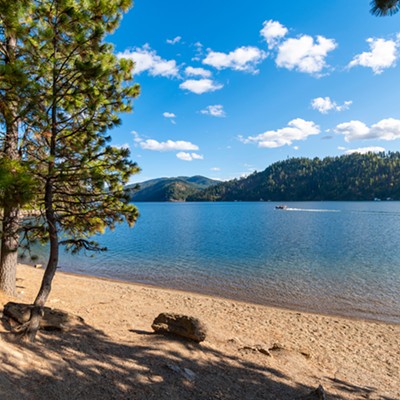Hallelujah! Coeur d'Alene's city leaders are on a visionary roll, seeking to bring a new stretch of waterfront into the city's boundaries.
The city is purchasing the last large stretch of unreconstructed mill waterfront property on the perimeter of Coeur d'Alene, left over from bygone days when lumber mills rimmed the city and logs floated the lake — the not-so-long-ago when lumber was king.
The property is generally referred to as the Atlas Mill site, covering 47 acres of land and 2,500 linear feet of riverfront on the north side of the Spokane River. The property is being sold by a company with the quizzical name of Bad Axe LLC, which will receive $7.85 million in the deal.
That 2,500 linear feet of waterfront has stirred the hopes and imagination of city leaders and large numbers of their interested constituents.
The city of Coeur d'Alene has been eyeing this now-empty property for some time. In 2014, the city purchased the railroad right of way that crosses the property from east to west — a smart move, since that right of way controls what happens to the waterfront. We hope that Mayor Steve Widmyer and the city council will agree that it's essential to keep the most valuable property, the waterfront, for the public to use.
A little more than 30 years ago, seven lumber mills were operating just outside the city limits of Coeur d'Alene. (The city fathers always respected the mills' desire to avoid city taxes.)
One by one, as the dollars fell out of the lumber market, the sites have been rewoven into the new economy. First, the Potlatch Mill was transformed into a handsome, green-velvet golf course. The DeArmond Mill was incorporated into an expanding college campus for North Idaho College, Lewis-Clark State College and the University of Idaho Coeur d'Alene.
The greatest impact on the city has been the development of the Riverstone addition, formerly Northwest Timber, a division of Pack River. With a big boost from our urban renewal agency, ignite cda, Riverstone has brought us a new shopping area, several restaurants, a Regal cinemaplex, condominium living and an enormous tax gift to ignite cda — a tax base that will very soon revert to the city.
We all eat, drink and shop at Riverstone. But the public has no access to the river of Riverstone. We don't swim, romp, kayak or paddleboard at Riverstone. The opportunity for public access to water at that large complex has been lost, probably forever.
Doug Eastwood, former Director of Coeur d'Alene's Park Department, and a newly appointed member of the Idaho State Parks Board, has written a piece for the Coeur d'Alene Press outlining how limited the beach access is within the city, even though the city is half-surrounded by water. Beach access for the public has been dwindling while the population has multiplied tenfold.
Doug points out that Sanders Beach on the eastern side of the city was once considered to be public. I remember 40 years ago, when families trooped to Sanders Beach on hot days throughout the summer. A large swim raft floated just offshore, always teeming with teenagers diving and flirting and having fun. Sun umbrellas, babies and beach balls covered the sand from one end of the beach to the other. Swimmers and floating devices dotted the water.
In recent years, fences and walls and "keep off" signs have replaced the water play. On weekdays, throughout the summer, Sanders Beach is one long row of empty sand, bookended by the busy but limited public areas at each end.
So there is clearly a real need for more beach access. And there is strong public support for keeping the entire length of the waterfront for public use.
Friends of the Spokane River Corridor, an organization formed in 2014 to advocate for the river and to preserve public access, has sponsored a "splash of blue" campaign to highlight the importance of water recreation to our area.
FSRC's knowledgeable river advocates firmly recommend that the city does two things with the Atlas site: 1) retain control of all the property between the railroad right of way and the river; and 2) have the city "ensure comprehensive planning for the entire Spokane River Corridor from Riverstone to Huetter, prior to development."
That's a big order, and a wise one.
This story marks only the beginning of the next life of the former Atlas Mill site. The land has just been purchased; the role of ignite cda is yet to be decided. Lots of decisions have yet to be made, and many dollars are yet to be spent.
Now is the time for the community to help with the planning and development of this fine new addition. For nearly a century, Lake Coeur d'Alene and the Spokane River made it possible for lumber mills to harvest and transport our region's natural bounty. We should cherish this last chance to make the most of our waterfront, the natural bounty they left behind.
River advocate Roger Smith said it well: "When I called it a 'once-in-a-lifetime' opportunity, someone corrected me, saying 'No, it's a once-in-forever-opportunity!'" ♦

















